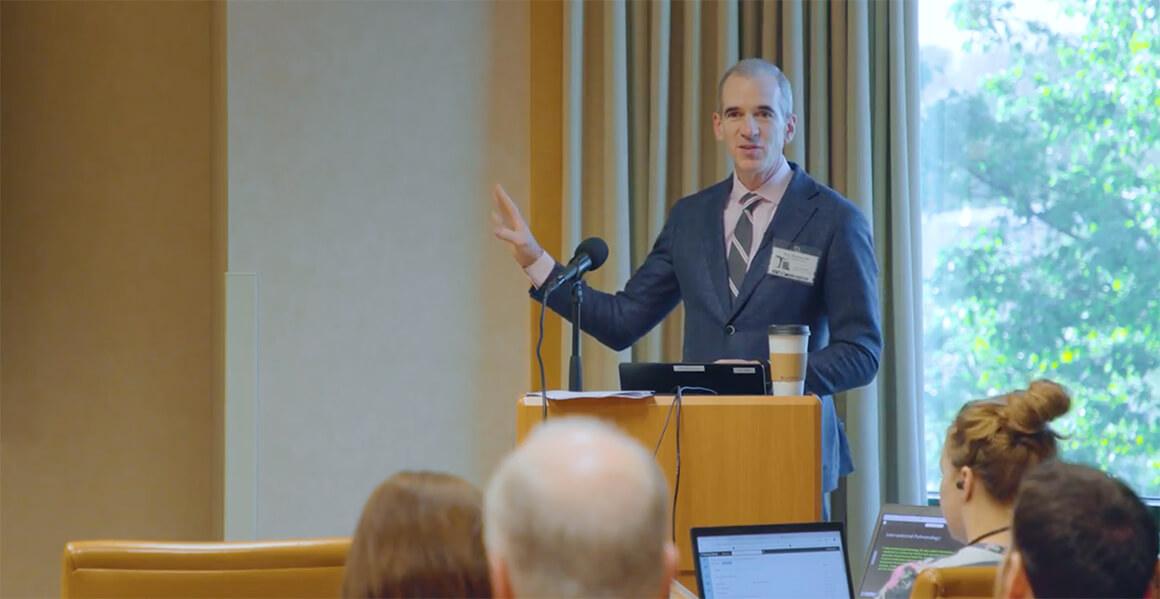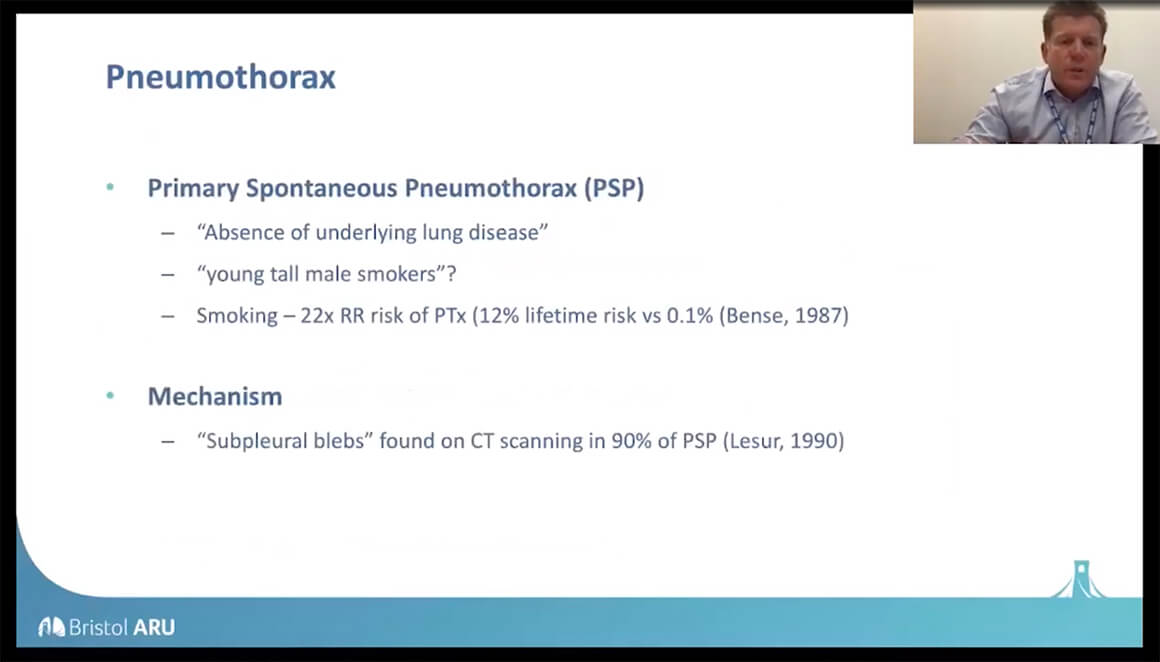A pleural effusion can develop from more than 60 different causes¹ and affects 1.5 million patients per year in the US.2 A patient with a pleural disease can receive treatment from practitioners of any number of hospital specialties, including internal medicine, critical care medicine, oncology, thoracic surgery, pulmonology, radiology, cytology and histology, and laboratory sciences.
On 7 May, two visiting physicians spoke to a full training room of Cook Medical employees from many different areas, including product management, engineering, clinical affairs, regulatory affairs, marketing, and sales, on the impact of this seemingly ubiquitous condition.
Wes Shepherd, MD, and Nick Maskell, MD, visited Cook to share their experiences with and predictions about advancements in the treatment of pleural disease.
This event, titled ‘Out of breath: The devastation of pleural disease’, is part of a programme within the MedSurg division called ‘MedSurg Presents’ that allows each of the six specialties within the division to educate one another on their specific customers, products, and procedures. The goal of this programme is to allow members of each of Cook’s six clinical specialties to educate one another on their specific customers, products, and procedures. Educational opportunities like these increase the collective knowledge of the MedSurg division and allow for possible, future collaboration efforts across specialties.
Dr Shepherd was the first to present. He is currently the director of interventional pulmonology, professor of pulmonary disease and critical care medicine, internal medicine, and has an appointment as professor in the department of surgery, at the Virginia Commonwealth University School of Medicine.
‘The treatment of pulmonary disease is a relatively unfamiliar concept’, began Dr Shepherd. ‘Malignant airway disease and lung cancer were really the driving force for the advancement of interventional pulmonology. Currently, IP fellowships across the US are growing, which is allowing the methods of treatment for pulmonary disease to continuously grow and develop’.
Pleural disease can include pleural effusions, both malignant and benign, empyema, pneumothorax, and pleural tumors. Minimally invasive, non-surgical procedures to treat pleural disease can include medical thoracoscopy or pleuroscopy, thoracentesis and chest tube placement, pleural manometry, and tunnelled pleural catheters, according to Dr Shepherd. These procedures are often paired with other methods of treatment, including percutaneous dilational tracheostomy, endobronchial lung volume reduction, and endobronchial ultrasound procedures, and can be performed in different departments of the hospital, including radiology, emergency medicine, general surgery, and thoracic surgery.
Recently, more patients are receiving treatment for pleural disease at outpatient centers rather than hospitals.
‘The number of thoracentesis procedures has been steadily decreasing’, he said. ‘Because the involvement from the radiology department has been increasing, there’s been a 52% increase to outpatient hospital treatments from inpatient hospital ones’.3
Dr Shepherd also attributed the increase in outpatient procedures to the advancement of other patient treatment options, including pleuroscopy and tunnelled pleural catheters.
‘Pleuroscopy can be performed in an ambulatory setting and only requires local sedation and one or two small ports to be made’, he said. ‘By comparison, video-assisted thoracic surgery requires general anaesthesia, multiple ports to be made, and often requires an operating room. Pleuroscopy is an excellent tool for the diagnosis of the exudative effusion of unclear aetiology, and in my experience, has been superior to blind pleural biopsy.
‘Tunnelled pleural catheters have been increasingly used to treat cancer-related pleural effusions, especially when patients have recurrent effusions’, Dr Shepherd said. ‘This can be done through outpatient management and is similar to a tunnelled IV catheter. Because of the increased popularity, tunnelled pleural catheters have growing indications for benign disease, including congestive heart failure, liver disease, and kidney disease’.
Because most cancers can metastasise to the pleural space,1 Dr Shepherd also emphasized rising global smoking rates in his presentation.
‘There are over 1.3 million deaths per year worldwide due to tobacco disease, and the worldwide smoker count is supposed to increase to 1.7 billion by 2025’, he said. ‘The worldwide tobacco-related mortality rate is predicted to be 10 million deaths per year by 2030, and it’s currently at 4.8 million. Additionally, 30% of people with lung cancer worldwide will develop pleural effusions, and around 5 to 6 million of these cases will result in pleural disease from lung cancer’.
Pleural effusion is the most common pleural disease.2 Due to the prevalence of the disease, there are a variety of cross-specialty management methods, according to Dr Shepherd. These methods include thoracentesis, tunnelled pleural catheters, pleuroscopy, video-assisted thoracic surgery, chemotherapy, radiation, palliative narcotics, pleuroperitoneal shunts, tube thoracostomy, and others. Because of the widespread nature of both the origins and treatment of pleural effusion, a cross-specialty approach must be taken.
‘Recently, there has been substantial progress, evolving literature, and increasing interest in combined techniques to approaching pleural effusions’, he said. ‘However, ultimately, we’re not searching for one “holy grail” treatment method; each case must be an individualised approach. This approach should be part of a shared decision-making process across specialties’.
Dr Maskell was the second to present. He is currently a professor of respiratory medicine at the University of Bristol and an honorary consultant at North Bristol National Health Service (NHS) Trust in Bristol, UK. Dr. Maskell also cochaired the development of the 2018 British Thoracic Society (BTS) mesothelioma guidelines and is one of the chairs for the forthcoming BTS pleural disease guidelines.
‘Recently, the goals of patient care for pleural disease have started to focus more on expeditious and efficient diagnosis, as well as minimally invasive patient treatment options’, he said. ‘This is partially because many European and US centers now have ambulatory pleural services. We’re moving more and more towards patient-centered care as well; it’s more about how the patients feel and their quality of life after receiving treatment, not what their chest x-ray looks like’.
Echoing Dr Shepherd, Dr Maskell highlighted the increasing importance and adoption of tunnelled pleural catheters for the treatment of pleural disease. He highlighted the first randomised controlled trial of talc pleurodesis that was administered via a tunnelled pleural catheter as an outpatient procedure.4
‘This first randomised controlled trial showed no difference in patient-centered outcomes when comparing an indwelling pleural catheter [IPC] and talc slurry’, he said. ‘Administering talc via an IPC should become the new standard of care in patients for whom it is an appropriate method of treatment. If you have a patient in whom you want to insert an IPC, administering talc, in my experience, will likely at least double their chances of achieving pleurodesis. There is also a suggestion in the literature of potential improvement of the patient’s quality of life through this method. IPCs will become increasingly important in the future as we think of more medications and therapies that can be delivered into the pleural space’. Dr Maskell suggested cancer treatment and fluid monitoring as future uses of IPCs.
Dr Maskell also spoke about the recent rise in malignant pleural effusion cases, a condition Dr. Shepherd highlighted as a driving force in developing the field of interventional pulmonology. He related the treatment of pleural effusions back to the rising trend of patient-centred care.
‘Malignant pleural effusions are increasing every year’, he said. ‘Patient choice should continue to lead the selection of treatment for malignant pleural effusions. In my experience, outpatient talc pleurodesis is very well tolerated and increases pleurodesis rates further than daily drainage alone. Currently, regarding patients with pleural disease, I believe that only patients with pleural infections requiring chest tube drainage need treatment in an inpatient setting’.
To close, Dr Maskell spoke again about the rise of outpatient services becoming the patient-preferred standard of care to manage pleural disease.
‘People don’t want to be stuck in the hospital’, he said. ‘They want to be as mobile as possible. That’s also ideal because it can decrease the chances of additional hospital complications. Currently, 90% of my patients are now completely treated in an outpatient setting. I truly think we’re moving more towards ambulatory methods of treating patients, including telemedicine. Though it can be said that it’s more difficult to manage patients in an outpatient setting, we as care providers must learn to adapt to changing patient preferences and provide the healthcare patients want’.
Drs Shepherd and Maskell are paid consultants of Cook Medical.
1. Hooper CE, Lee YC, Maskell NA. Setting up a specialist pleural disease service. Respirology. 2010;15(7):1028-1036.
2. Krishna R, Rudrappa M. Pleural effusion. StatPearls Web site. https://www.ncbi.nlm.nih.gov/books/NBK448189/. Updated February 11, 2019. Accessed August 26, 2019.
3. Duszak R, Chatterjee A, Schneider D. National fluid shifts: fifteen-year trends in paracentesis and thoracentesis procedures. J Am Coll Radiol. 2010;7(11):859-864.
4. American Thoracic Society. Management of malignant pleural effusions. Am J Respir Crit Care Med. 2000;162(5):1987-2001.

